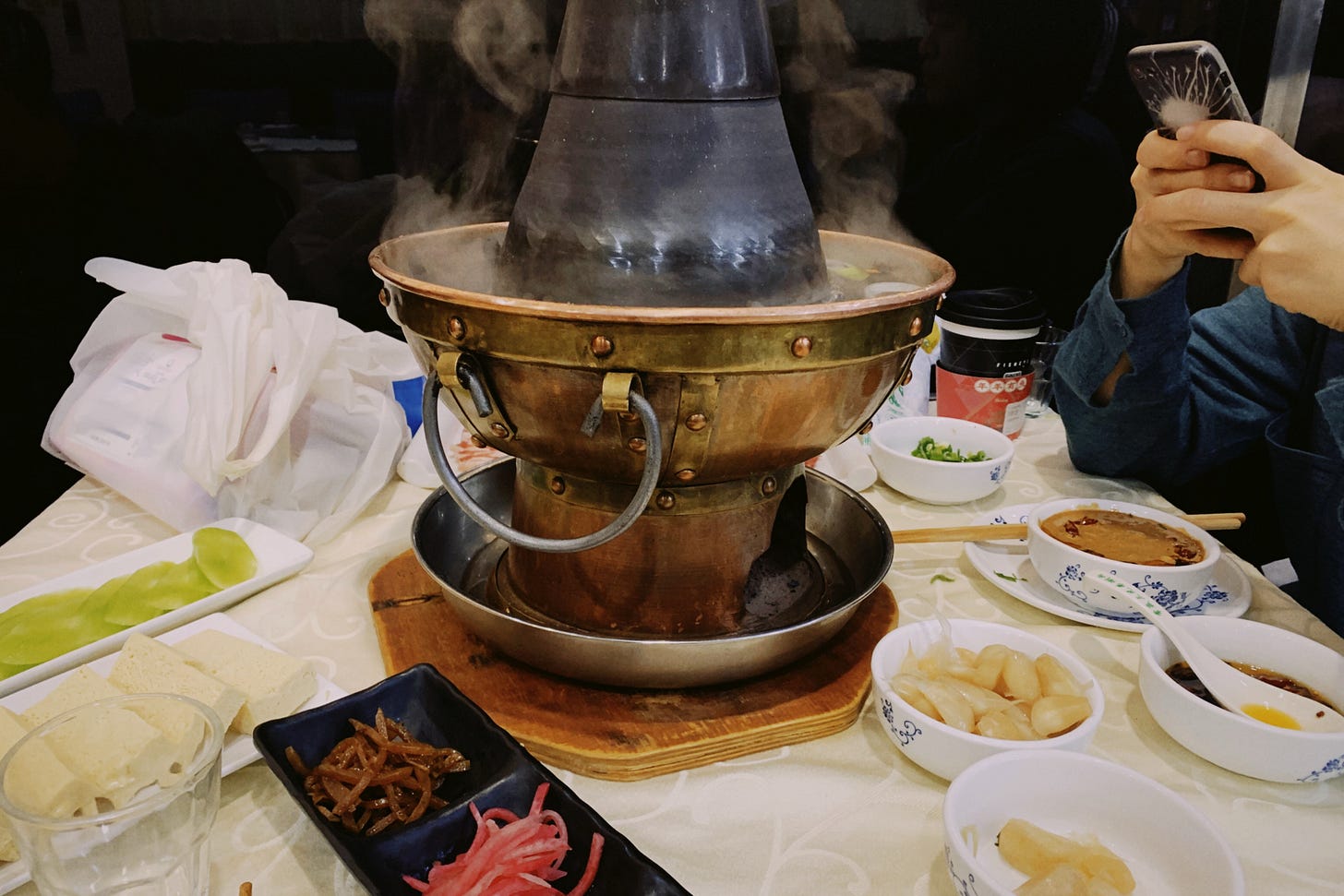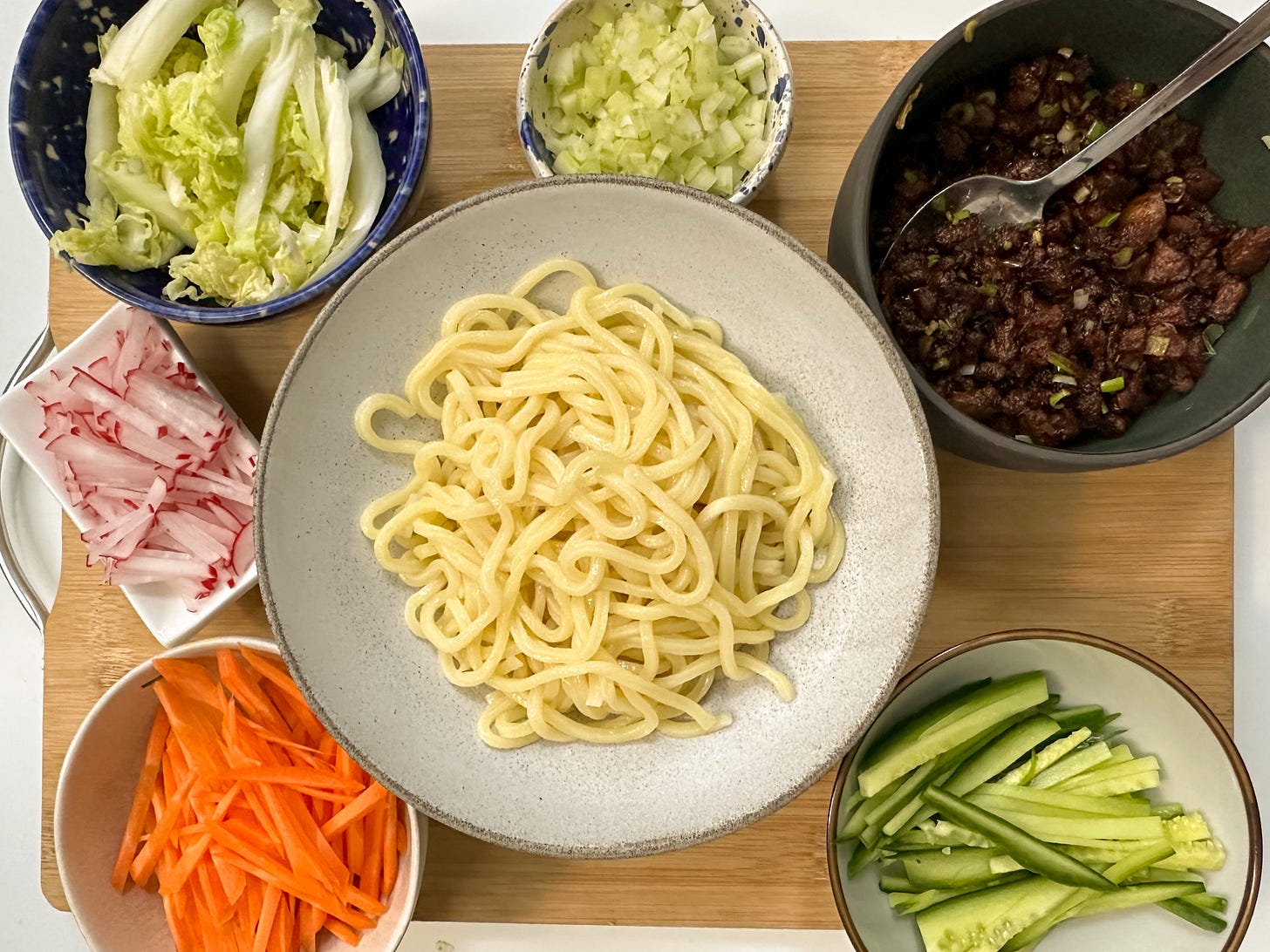Beijing Fried Sauce Noodles (Zha Jiang Mian)
Rich, savory and umami—could zha jiang be the Chinese answer to bolognese?
Hi! It’s been an intense week for many and I hope you’re doing ok. Here in Berlin, the weather has shifted completely to winter mode, and I’ve found myself spending more hours in the kitchen, experimenting with stews and working with flour again (it’s been a while since I tackled a dough recipe!). This time, I turned to a noodle dish from the Beijing area. Though it’s traditionally enjoyed in summer there, for me, it feels like a warm hug on these gloomy days.
In 2014, the year before I graduated from college, I spent a few months in Beijing doing an unpaid internship and preparing for language tests. Beijing was beautiful and exciting in many ways: I’d go to theater plays with student discounts, spend afternoons in bookshops and wandering around the hutongs. But when it came to food, Beijing wasn’t my favorite city to eat. In fact, some netizens jokingly call it the “food desert” of China. You’d likely pay twice the price for just an adequate Sichuan hot pot. To save money, I often ate at fast food chains or in shopping mall food courts. Still, two Beijing dishes stayed with me: lamb hot pot (shuan yangrou 涮羊肉) and zha jiang mian (炸酱面). The former, served in a copper pot with coal is a delicacy unique to Beijing, but zha jiang mian—an essential home-cooked dish—is something I can possibly recreate at my home.

Zha Jiang (炸酱), which means “fried sauce” in Chinese, is a noodle topping popular in northern China, especially around Beijing. While today it’s most often made with pork belly (known as hun zha jiang, or “meaty fried sauce”), there are vegetarian versions (su zha jiang) as well as lamb and shrimp variations, according to a book about traditional Beijing cuisine1. The pork is slowly fried with two Chinese sauces: sweet flour sauce and fermented soybean paste. This rich, savory sauce is poured over thick wheat noodles and served with fresh toppings. The result is hearty and satisfying, yet balanced by the bright crunch of vegetables, almost like a noodle salad. Chinese immigrants brought this dish to Korea in the late 19th century, where it evolved into jajangmyeon, made with black bean sauce. It may also have inspired Sichuan-style dry-tossed noodles with minced meat, known as za jiang mian (杂酱面, find my recipe here).
I first developed this recipe two years ago, and as I revisited it recently, I researched through a few Chinese cookbooks and improved the recipe. This dish is all about building layers of flavor—slowly frying the alliums, rendering the fat, and simmering the sauce until everything melds together beautifully. Unlike other Chinese noodles, you don’t need to season the noodles themselves; the zhajiang does all the work.
This recipe takes a little effort, but if you think of it as a Chinese answer to a great bolognese sauce, it’s worth every step. Your kitchen will be infused with amazing aromas as it cooks. And it’s great for meal prep: make a big batch, divide it into single portions, and you can reheat it over rice or noodles. My partner even likes dipping his Abendbrot (German bread dinner) into it!
Recipe for Beijing Zha Jiang Mian (北京炸酱面)
Ingredients
For the aromatic scallion oil (makes 1/2 cup):
120 ml (1/2 cup) vegetable oil
5 scallions
1 shallot
3 sprigs of cilantro, preferably with roots
1 star anise
For the zha jiang sauce (makes 4 servings):
450 g (1 lb.) pork belly
2 thick slices of ginger
4 tbsp (1/4 cup) fermented soybean paste
2 tbsp sweet flour sauce (tianmianjiang)
1 tbsp Shaoxing wine
1 tsp sugar
1 tsp dark soy sauce
For each serving bowl:
100 g thick wheat noodles (broad Chinese wheat noodles, Korean jajangmyeon noodles or udon work well)
Toppings:
Carrots, cucumber, celery, radish (raw), Napa cabbage (blanched)
Instructions
Make the scallion oil: Separate the scallion whites and greens. Cut the greens into 3 cm slices for the oil, and finely mince the whites and light grenn parts, setting them aside for later. In a small pot, heat the vegetable oil over medium heat, add the scallion greens, shallot, cilantro with roots, and star anise. Fry on low heat for about 15 minutes until golden brown, then strain the oil. (You can prep your toppings while this cooks.)
Prepare the pork belly: Remove the skin, then separate the fat and lean parts if possible. Cut both into small 1-2 cm cubes.
In a frying pan, add about 2-3 tbsp of the scallion oil. Over medium heat, fry the pork fat for 10-12 minutes until the fat renders and the oil turns clear. Then add the lean pork, with ginger slices, and fry for another 8-10 minutes, until the oil is clear and the water has evaporated. Lower the heat.
In a bowl, mix the soybean paste, sweet flour sauce, and Shaoxing wine until smooth. Add this mixture to the pork, along with the sugar and dark soy sauce, and stir well. Cook on medium-low heat for 20 minutes while occasionally stirring. In the last five minutes, add the minced scallion whites in 2-3 batches. Keep warm on the lowest heat setting.
Cook the noodles according to package instructions, drain completely, and place in serving bowls. Top with 3-4 tablespoons of the zha jiang sauce, then add your choice of toppings.
(Tip: You can use leftover scallion oil to make scallion oil noodles or as a versatile cooking oil.)
Tips for Making the Best Zha Jiang Mian at Home
Choose the Right Sauces:
Traditional Beijing chefs combine three types of sauces: sweet flour sauce (tianmianjiang, 甜面酱) with two fermented soybean paste: a dry version called gan huangjiang (干黄酱) and a wet version known as huangdoujiang (黄豆酱). The dry version has a miso-like texture and a more intense flavor, but it’s hard to find outside China, so I use a combination of sweet flour sauce and regular soybean paste for a balanced savory-sweet profile. These can be found in your local Asian grocery stores—brands like Wangzhihe and Haitian are common.
if you can’t find it, make tianmianjiang at home: combine 100g water, 2 tbsp flour, 1 tbsp light soy sauce, 2 tbsp dark soy sauce, and 1.5 tbsp sugar in a pan. Simmer it over low heat while whisking until it becomes a dark paste.
Pork-to-Sauce Ratio:
Don’t skimp on the sauce! The ideal pork-to-sauce ratio is around 2:1 or 3:1 in weight (some recipes even go as high as 1:1). My recipe uses about 450g of pork and 150g of sauce in total. When adding the sauce, keep the heat medium-low to prevent burning, and stir occasionally to meld the flavors.
Choice of Meat:
I recommend pork belly for a juicier, more flavorful result, though ground pork is a quicker alternative. If using ground pork, make sure to find those with fat. For pork belly, rendering the fat first adds the aroma, while adding the lean part later helps prevent overcooking.
Different Uses of Scallion:
Adding fresh scallion whites at the end, a technique known as daoqiangguo (倒炝锅)2, intensifies the aroma. This tip is commonly used in northern-style homecooking, which I learned from Xu Wenbing’s book Meishike (《美食课》) brings a fresh, strong scallion flavor to the finished dish, creating a layered profile that’s key to zhajiang mian.
Toppings:
Known as cai ma (菜码) in Beijing, toppings vary by season and region. Options include blanched Napa cabbage, spinach, garlic chives, celery, radish, and cucumber. Any crunchy or leafy vegetable can work, like bean sprouts or sugar snap peas. I’ve also used cooked edamame before. If you’re cooking for more than yourself, you can easily make this into a noodle bar so your guests could pick their own toppings.
Make this dish vegetarian:
Yes, you can omit the pork and make the scallion oil plus sauce on its own, or use scrambled eggs, fried mushrooms, or tofu for added texture. Cook them to your liking, then add to the sauce in Step 4.
《闾巷话蔬食》Lv Xiang Hua Shu Shi by Li Chunfang and Fan Guozhong is a book dedicated to folk cuisine and culinary traditions in old Beijing.
Daoqiangguo is a technique also used in noodle and vegetable dishes, where aromatics and seasonings are added directly to cooked noodles or blanched vegetables.








Zha jiang mian is one of my favourites! You can make a really good vegan one with eggplant
This is a really interesting article. I looked for years before I found what I thought was the perfect recipe, Cecilia Chiang’s in The Seventh Chinese Daughter. I look forward to trying your version(s)